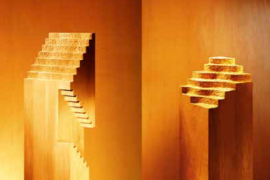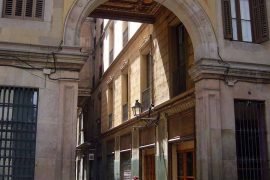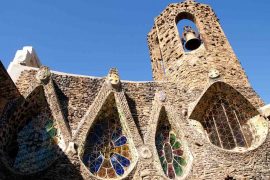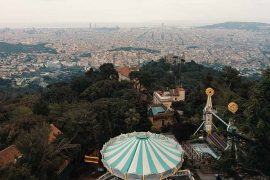[dropcap letter=”W”]
e are at the highest point of Barcelona. From here the Expiatory Temple of the Sacred Heart, at the Tibidabo, seems to control everything that happens in the city. Just looking up at the mountains, one notices the omnipresence of a temple that can be taken as a perfect starting point to explore the Barcelona of Enric Sagnier (1858-1931) and discover one of the city’s great architects.
He was able to adapt to the taste of the Catalan bourgeoisie and ended up becoming one of its leading architects
Enric Sagnier was not only in charge of projecting the temple that is visible on the Tibidabo peak, but also responsible of 300 other works throughout the city that made him the most prolific architect in Barcelona. Nobody built more than him and, despite this, the social recognition that he currently enjoys is scarce compared to his architectural contribution. In the age of social networks and marketing, Enric Sagnier could be considered one of the great absentees in the collective imaginary of the modernist Barcelona of Antoni Gaudí, Josep Puig i Cadafalch or Lluís Domènech i Montaner.
 Enric Sagnier was their contemporary, although the social chronicles of the time explain that he never considered himself an artist, but rather a good professional. Neither he conformed to styles nor canons, always prioritizing the sobriety and functionality of his works, whether they were modernist projects or classic ones. He was able to adapt to the taste of the Catalan bourgeoisie and ended up becoming one of its leading architects. Many of his works were private requests and homes for important families of the late nineteenth century Barcelona. Casa Arnús is probably one of the most significant. ‘El Pinar’, name of the residence of doctor Manuel Arnús on the Carretera de les Aigües, near the Tibidabo funicular stop, shows Gothic style, notably volumetric and polychromic. From there we descend to Brusi street, to discover what was the summer house of the Sagnier family, and the gardens that the city of Barcelona recently dedicated to Sagnier. The fourth stop of this particular journey takes us to the very Avenida Diagonal. Next to Passeig de Gràcia, and between two modern office buildings, we find the Church of Our Lady of Pompeii.
Enric Sagnier was their contemporary, although the social chronicles of the time explain that he never considered himself an artist, but rather a good professional. Neither he conformed to styles nor canons, always prioritizing the sobriety and functionality of his works, whether they were modernist projects or classic ones. He was able to adapt to the taste of the Catalan bourgeoisie and ended up becoming one of its leading architects. Many of his works were private requests and homes for important families of the late nineteenth century Barcelona. Casa Arnús is probably one of the most significant. ‘El Pinar’, name of the residence of doctor Manuel Arnús on the Carretera de les Aigües, near the Tibidabo funicular stop, shows Gothic style, notably volumetric and polychromic. From there we descend to Brusi street, to discover what was the summer house of the Sagnier family, and the gardens that the city of Barcelona recently dedicated to Sagnier. The fourth stop of this particular journey takes us to the very Avenida Diagonal. Next to Passeig de Gràcia, and between two modern office buildings, we find the Church of Our Lady of Pompeii.
Here we stop along the way to discover one of the highlights not only of the work, but also of the life of Enric Sagnier: his deep Christian faith. A Catholic and a practitioner, Sagnier devoted a great part of his life to religion from his professional side, reaching the degree of diocesan architect of Barcelona. His are some of the main parishes built in the working-class neighbourhoods on the outskirts of the Catalan capital, between the end of 19th century and the beginning of 20th. He was also appointed official architect of the Basilica of Montserrat in 1903 and the Cathedral, and Pope Pius XI, in recognition, granted him with the title of Marquis de Sagnier in 1923.
Eclectic, not only had he time to project an average of 10 works per year, but also to devote himself to the political life of the city. His brother Joaquim was mayor of Barcelona (1913-1914) and he became deputy twice
FROM VATICAN TO PERTH
Marquis and unclassifiable architect, Enric Sagnier is also present in one of the great arteries of Barcelona. Our journey stops, now, at the Passeig de Gràcia, specifically in front of numbers 2-4. There we find the Casas Pascual i Pons commissioned by the brothers Sebastián and Alexandre in 1890. A few numbers above, at 37, we find Casa Mulleras. Its ornamental sobriety and neoclassical style moves away from the modernism of the buildings that make up the so-called ‘apple of discord’ in which Casa Lleó Morera, Casa Batlló and Casa Amatller, respectively by Dómenech i Montaner, Gaudí and Puig i Cadafalch, are found. The splendour of modernism in Barcelona in a few square meters, and a contrast of styles that allows us to understand how unclassifiable Enric Sagnier was at his time, and still remains.
The works of Enric Sagnier have something special: I do not know if it could be called the “curse of everyday life”, a curse that makes them go unnoticed, precisely because those buildings are so present in the lives of the people of Barcelona
Eclectic, not only had he time to project an average of 10 works per year, but also to devote himself to the political life of the city. His brother Joaquim was mayor of Barcelona (1913-1914) and he became deputy twice. Always in the hands of the Catholic section of the Regionalist League. Catholic and conservative, Enric Sagnier came from a wealthy family in Barcelona. His father was president of the Caixa d’Estalvis (Savings Bank) and he, as an architect, was responsible in his adulthood to design the headquarters of Caixa de Pensions de Barcelona at Via Laietana. Yes, we mean that building that is really close to the Plaza Urquinaona, in front of which all of us have walked so many times. The works of Enric Sagnier have something special: I do not know if it could be called the “curse of everyday life”, a curse that makes them go unnoticed, precisely because those buildings are so present in the lives of the people of Barcelona. That familiarity, however, should not diminish the value of the works. The last work referred, for example, was a pioneer in using reinforced concrete and stone cladding.
As it was said at the beginning of the article, Enric Sagnier always preferred to be considered a professional of architecture rather than an artist. That was his great recognition in life. So much, that his savoir faire went beyond borders and even oceans. In the Australian city of Perth, Enric Sagnier designed the New Nursia building thanks to a Catalan missionary, Fulgenci Torres Mayans, who knew the work of the most prolific architect of the city of Barcelona. An honour, according to which he should be included in the architectural routes of the city. The Palace of Justice at the Passeig Lluís Companys and the Customs Office of the Barcelona Port at Colón are the last two stops of a much wider route. But, for this winter Saturday, that may be enough. The most curious ones will be glad to know that the Sagnier family has been vindicating the figure of the architect for years, and on the web www.enricsagnier.com one can find listed and located most of the works of the unclassifiable and eclectic modernist architect. Also, some of those that have not reached our days, such as the old Barcelona Frontón or the first Hotel Colón de Plaza Catalunya.


















